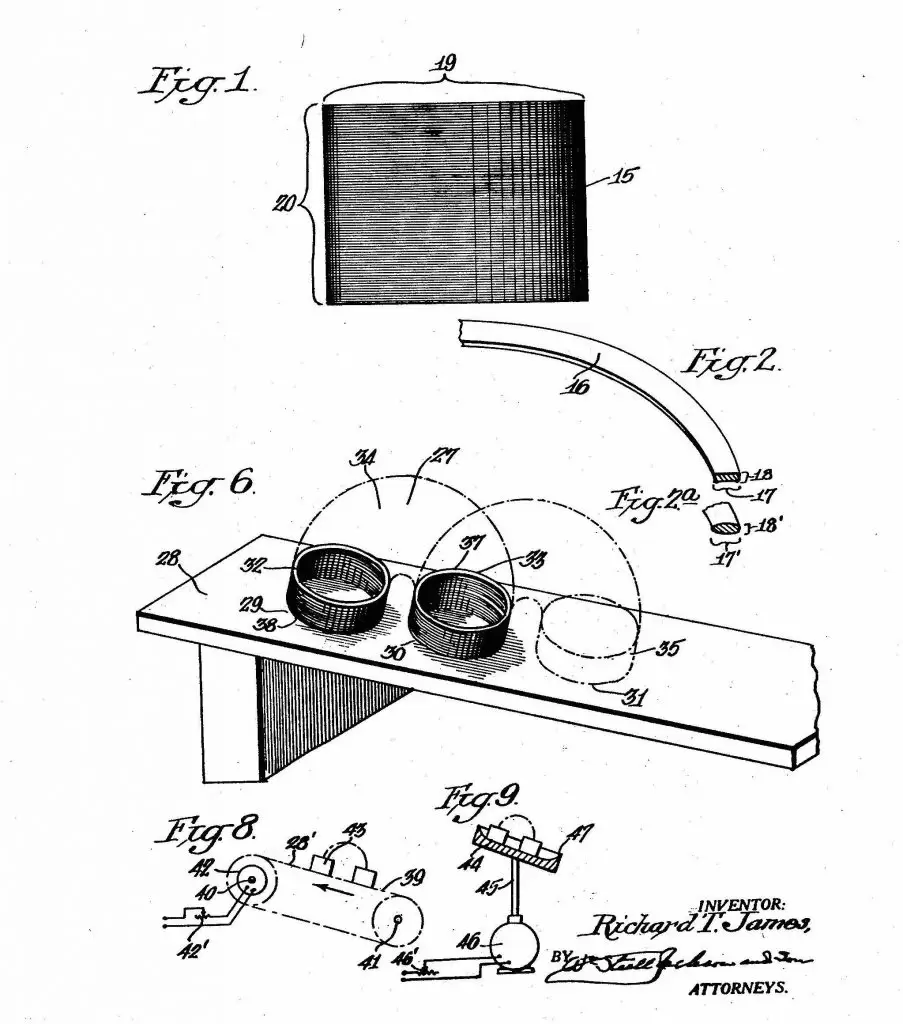If you’ve ever wasted hours watching a Slinky meander down stairs, it turns out you have a mechanical engineer to thank.
Richard James wasn’t looking to invent a new children’s toy when he stumbled upon the Slinky. Like other notable toy inventors, he was attempting to solve an entirely different problem. In this case, keeping ship equipment secure when sailing rocky seas.
It was 1943 and James was working for the Cramp Shipbuilding Company on the Delaware River in Philadelphia. Being in the midst of World War II, the company employed more than 18,000 men and women to build ships for the US Navy.
James, a mechanical engineer, was attempting to develop a new type of tension spring and accidentally knocked a prototype off of his desk. Rather than bouncing back up like a traditional spring, James noticed it “walked down from its spot”.
Sinuous and graceful
The accident gave James the idea to create a toy based on the spring, and so he turned to the person who would become a pivotal inclusion in the history of the Slinky, his wife Betty.
It was Betty who found a name for the new toy by flipping through the dictionary. She thought the term ‘slinky’, meaning “graceful and sinuous in movement”, aptly described the way it tumbled along.
James also brought in his co-workers and fellow engineers Coleman Barber and Dylan Gedig. Together they applied for a US$500 loan to further develop the idea and start James Industries.
The original Slinky was 6.35 cm tall and made from 22.9 metres of high carbon steel wire, twisted into 98 coils. In the patent for the Slinky, lodged in 1946, James said it could be “manufactured from various materials as required, it has been found that for best results a suitable spring steel such as SAE 1050 to SAE 1095 is desirable, of course suitably heat treated to develop spring properties.”
His patent even included the exact mathematical equation for the toy.

Just before Christmas 1945, James demonstrated the Slinky at Gimbels department store in Philadelphia. Betty was nervous that the demonstration would flop, and so organised for a friend to go and purchase a Slinky.
“I gave her a dollar and I said, ‘Let’s go down and we’ll each buy one to make him feel better’,” Betty later recalled. “Well, we got off the elevator and over in one corner there were just hundreds of people waving dollar bills. And my husband was in the middle of it.”
James had sold his stock of 400 Slinkys within two hours.
After the war, James developed a machine to mass produce Slinkys, which could coil a Slinky in 10 seconds. The coiling unit used by modern Slinky manufacturers remains largely the same, however for safety reasons each end is now crimped to avoid children cutting themselves on the sharp wire.
The toy peaked in popularity in the 1950s but James’s interest in the Slinky began to wane as he became involved with a religious sect in Bolivia. In 1960, James left Betty and his six children to become a missionary for the sect.
Slinky’s second wind
Unlike James, Betty continued to see the potential of the Slinky. She established a factory in Pennsylvania and even mortgaged her home to go to a toy show in New York in 1963.
The 60s saw a renaissance of the Slinky, helped in part by the enduring jingle created by Betty: “What walks downstairs alone or in pairs/ And makes a slinkity sound?/ A spring, a spring, a marvelous thing/ Everyone knows it’s Slinky!”
What Betty probably didn’t foresee was the versatility of the toy.
During the Vietnam War, soldiers found an inventive use for the children’s toy, repurposing it as a radio antenna. They would attach one end to their radios and toss the other end over a tree, giving themselves a clearer signal.
In 1985, astronaut Margaret Rhea Seddon took a Slinky into space to demonstrate zero gravity. “’It won’t slink at all,”’ Seddon said in a telecast from the Discovery Space Shuttle. ”It sort of droops.”
According to the US National Wildlife Foundation, some bird watchers use Slinkys to to stop squirrels getting into bird feeders. “The squirrels will try to jump onto the pole, grab the Slinky and promptly find themselves dumped to the ground,” said one birder.
After her husband left, Betty continued to run James Industries for another 38 years, finding new and interesting ways to reinvent the Slinky. The Slinky train and later the Slinky dog are some of the most iconic developments of this time. After the Slinky dog appeared in the 1995 film, Toy Story, James Industries had to boost manufacturing of the product from 12,000 a year to 40,000.
In 1998, Betty sold James Industries to Proof of Products, which renamed itself to Proof-Slinky.
The Slinky was named Pennsylvania’s official state toy in 2001, and in the same year Betty was inducted into the Toy Industry Hall of Fame.
Before her death in 2008, Betty mused to NBC about the popularity of the Slinky.
“It’s one of those things that once you get it in your hand, it’s hard to put down,” she said. “I’ve often said that it reminded me of eating peanuts. Once you get it started, you don’t want to put it down.”
